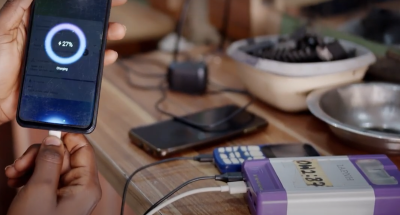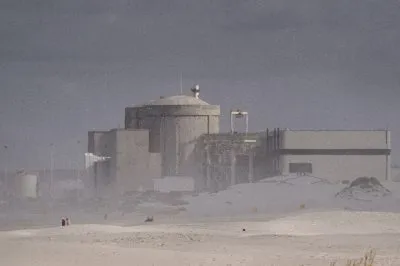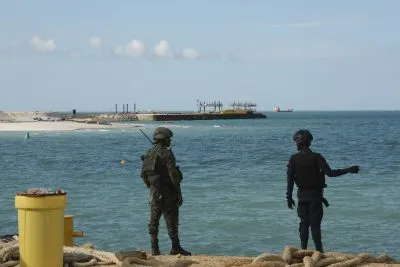Located in the northwest of Malawi’s Karonga district, just a few kilometres from the border crossing with Tanzania at Songwe, the once highly populated and internationally known Kayelekera uranium mine is now abandoned.
In 2014, mining operator Paladin Africa Limited (PAL), a subsidiary of Australian Paladin Energy, suspended production due to falling prices for uranium coupled with high operating costs.
Prices for the commodity have plummeted from a high of $140 per pound in 2007 to just over $30 per pound in March 2016, and countries such as Malawi have been hard hit.
Harrison Kayira, one of the few remaining employees at the mine, points out the impact on the area: “During the mining operation, we were more than 2000 but now we are only 213 employees.”
“Look here,” he says, pointing at the abandoned mining settlement area. “All these shelters were occupied by people migrated to the area for business and other economic opportunities.”
Paladin suspended production at Kayelekera just five years after its inception.
“Kayelekera mine continues to operate at a loss due to the low prevailing price,” the company’s managing director, John Borshoff, said at the time. “Paladin is unable to continue to provide the level of financial support that PAL has required in recent years, hence the decision at this time.”
According to the district-based development analyst Yotamu Kaunda, the mining suspension has accelerated poverty levels among thousands of people.
“Apart from employing hundreds of Malawians, most of the locals here could supply agricultural products, such as fruits, rice, fish and meat at high prices to the company, and this improved economic standards of most people,” he explains.
He says the mine also attracted both local and international investors, including Chinese and Indian business operators who built local infrastructure such as banks and shops in the district, and employed the youth as shop keepers.
For his part, Dr Goodall Gondwe, Malawi’s minister of finance, economic planning and development, says that until 2014 the Kayelekera uranium mine was generating 10% of the county’s GDP.
“Paladin also invested a lot in education, water and health sectors by establishing schools, water facilities and health facilities as part of its social responsibility. We no longer see these projects since the suspension,” he says. The company also announced its decision to suspend evaluation of a major stage 4 expansion of its Langer Heinrich mine in Namibia.
“We will not contemplate any such expansion until uranium prices reach at least $75 per pound and are sustainable or are above this level,” Borshoff said in a statement. The move has taken millions of pounds in annual production off global markets.
Dr Henry Kachaje, president of the Economics Association of Malawi (ECAMA) told African Business that “the impacts are quite huge and they include the instability of the prices of the local currencies against the dollar. Uranium production was like a stable source of forex for a number of countries.”
He cites Malawi as an example. “During operation of the Kayelekera mine, $1 was trading against 150 Malawian kwacha. Now it’s at K750,” he says.
Growing demand for nuclear power?
Despite the downturn, uranium exploration on the continent looks set to witness a resurgence. According to projections from the International Atomic and Energy Association, global nuclear power generation could increase by as much as 94% by 2030. And this despite the backlash caused by Japan’s Fukushima disaster. Africa is home to 18% of known global uranium reserves, with Niger and Namibia making the top five in terms of production levels.
Namibia supplies 8% of global production with an estimated annual 284,200 tonnes of uranium (tU). At 275,500tU Niger accounts for 7%, followed by Malawi at 1.2% and South Africa at 1%.
Namibia has over six uranium mines including Rossing, Husab and Langer Heinrich. The Rossing mine is owned by Rio Tinto, the world’s largest mining group, supplying power stations in Japan, France, the USA and the UK. The Langer Heinrich mine is operated by Langer Heinrich Uranium, a subsidiary of Paladin Energy, while Husab is owned by China General Nuclear Power Group.
And in Niger, the Arlit mining operation is the country’s largest uranium producer. It comprises several open pits exploiting four main uranium deposits: Arlit, Tamou, Tagora and Artois in northwestern Niger. The mine is owned and operated by Société des Mines de l’Air (Somair), and ranks as the fourth largest producer of uranium in the world after the McArthur River mine of Canada, and the Olympic Dam and Ranger mines of Australia.
The uranium mining industry’s contribution to economies such as Namibia is significant. Robert Grant, senior partner at the audit, tax and advisory services provider KPMG Namibia, says that in 2011/12 the country earned more than $1bn in foreign direct investments in the mining sector alone. Uranium production accounts for as much as 15% of the country’s GDP.
More exploration is taking place in Tanzania, Botswana, the Democratic Republic of Congo, Zambia, Central African Republic and other countries. Some analysts estimate the continent could be the world’s second largest supplier of uranium in the near future, after Australia.
Henry Kijimwana Mhango
Want to continue reading? Subscribe today.
You've read all your free articles for this month! Subscribe now to enjoy full access to our content.
Digital Monthly
£8.00 / month
Receive full unlimited access to our articles, opinions, podcasts and more.
Digital Yearly
£70.00 / year
Our best value offer - save £26 and gain access to all of our digital content for an entire year!

 Sign in with Google
Sign in with Google 


